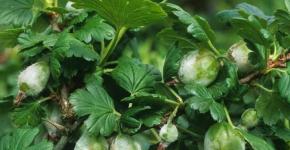Tulip - description
In nature, tulips grow in the Central Asian region, which includes countries such as Tajikistan and Turkmenistan, Uzbekistan and Pakistan, India, Nepal and China, as well as Mediterranean countries: Spain and Morocco, Italy and the Netherlands. Tulips are common on the Balkan Peninsula and in the rather harsh nature of the Scandinavian countries.
Many species and cultivars grow in city flowerbeds and in private household plots in the states of the former Soviet Union and Eastern Europe. These flowers easily withstand the climatic conditions of mountainous, desert and steppe regions, dry summers and harsh winters.
Where did the word "tulip" come from?
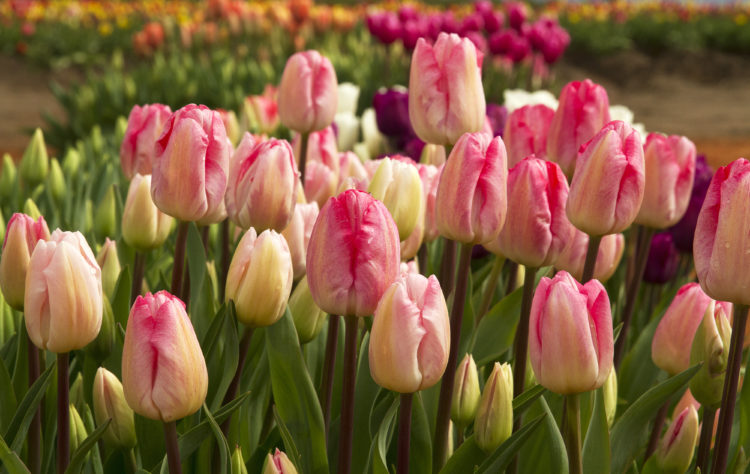
In European languages, the name of the tulip flower came from the Ottoman-Persian dictionary. The word "tülbend" meant a fabric for a national headdress. Later, this concept began to correspond not only to the material from which it was made, but also to the turban itself, which had an outward resemblance to a flower. Probably, the borrowing took place almost simultaneously in the countries of Eastern and Western Europe, therefore the Italian "tulipano", the Polish "tulipan", as well as the German "tulpe" and the Dutch "tulp" that have lost the "an" ending, have a common root. The word tulip entered the Russian language as a free reading of the Polish name of the plant.
Tulip - description
Tulips are herbaceous plants that have a very short growing season.
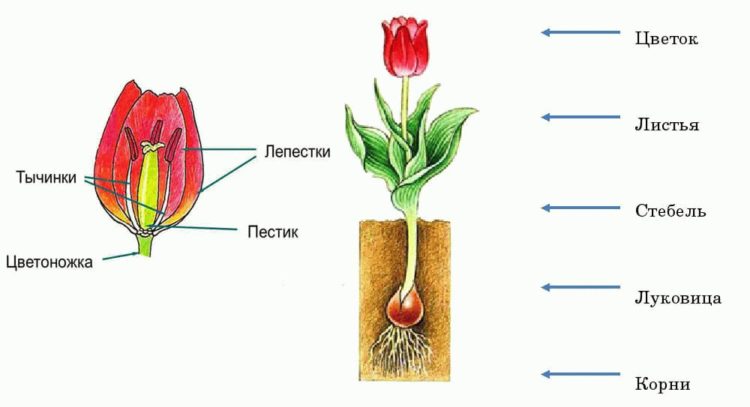
Tulip structure
In the morphological structure of the tulip stand out:
- Tulip bulbs, having an ovoid or pear-shaped form. On top of the bulb covers the covering scales. In the appearance of the bulb, a flattened bottom and a pointed top are clearly visible. The size of the tulip bulb, the color and shape of the scales differ depending on the species. Inside it are special scales that supply the plant with nutrients. After the depletion of all reserves, the tulip bulb dies off, and several new ones appear in its place. The life of the bulb in natural conditions does not exceed 2 years.
- tulip root located on the bottom of the bulb. At the young seedling stage, the plant has one main root, which dies off after the first growing season. Subsequently, the tulip annually grows a new root system, consisting of many filamentous roots.
- Stolon, which is a kind of underground stem of a plant. With the help of it, the annual vegetative reproduction of tulip bulbs takes place. The stolon serves to deepen the bulb bud into the ground, as well as to protect and nourish it.
- Fruiting erect tulip stem cylindrical shape, on which are located from 1 to 9-12 leaves. At the end of the season, the stem dies off. The height of the tulip stem depends on the type and variety of the plant and can be from 15 to 70 cm.
- tulip leaves, which have an elongated pointed or elongated oval shape. They are located directly on the stem, tightly clasping it. Some species have comb-like outgrowths on the leaf surface.
- tulip flowers, which consist of three inner and three outer petals. Hybrid tulip species may have more petals. Usually one bud is formed on one plant, although there are types of tulips that are characterized by the development of several buds. The shape of a tulip flower can be oval, star-shaped, cupped, double, goblet or fringed, and the color of a tulip can be solid, mixed or two-tone. The color of tulips depends on the combinations of anthocyanins, carotenoids and flavonols - natural dyes. In healthy plants, the inflorescences are directed strictly upwards, although some varieties of tulips have drooping flower stalks.
- tulip fruit, which is a rounded trihedral box. Inside it are triangular or ovoid tulip seeds, which, after ripening, fall to the ground and are carried by the wind.
Kinds
Tulip great - a perennial bulbous plant up to 45 centimeters high, with wide bluish-green leaves. The flowers are solitary, wide open, goblet-shaped, up to 14 centimeters in diameter, bright red with a black-violet center. The flowering period begins at the end of April.
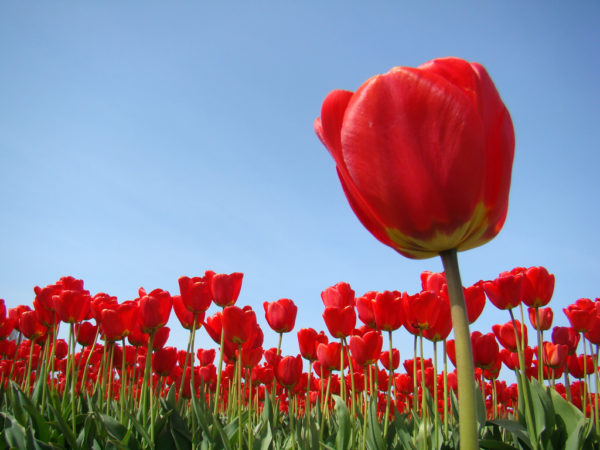
tulip hairy stamen - perennial bulbous plant up to 25 centimeters high, with linear smooth leaves of light green color. Flowers solitary, up to 5 cm in diameter. Golden yellow tulips. Flowering begins in mid-April and ends in early May.
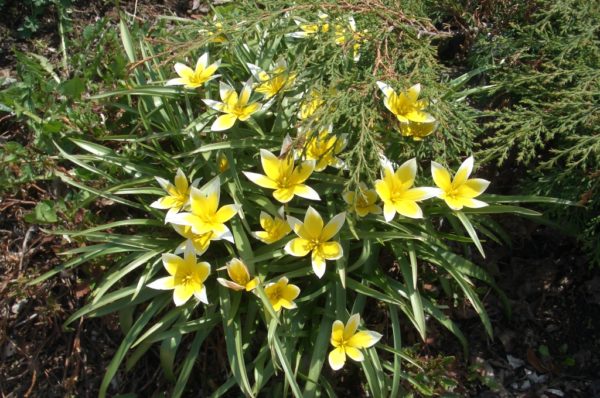
Tulip Kaufman - a bulbous plant with a stem height of up to 20 centimeters and wide leaves with dark veins. Single flowers up to 8 centimeters in diameter. The outer surface is yellow, the pharynx is raspberry-pink. The plant begins to bloom in mid-April, some varieties and hybrids already in early April after the snow melts.
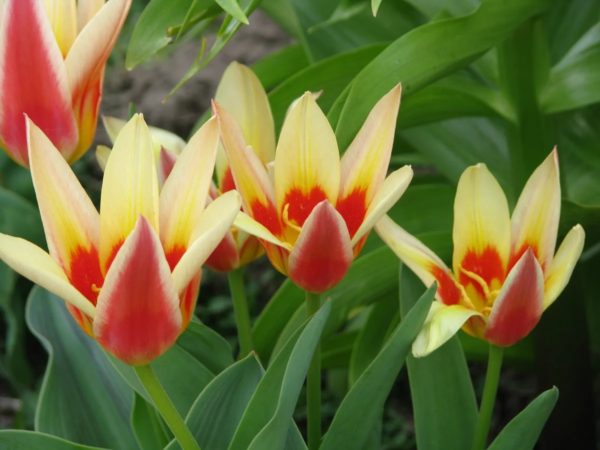
Tulip superb - perennial bulbous plant up to 30 centimeters high. Leaves are wavy, recurved. The flowers are wide open, up to 14 centimeters in diameter, with narrow bright red petals and a yellow throat. The flowering period begins in early May and lasts an average of 10 days.
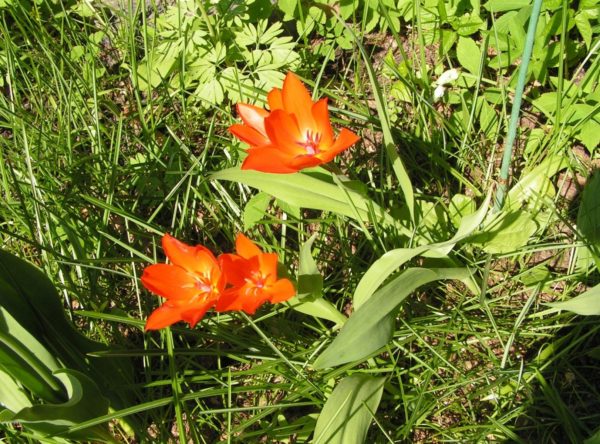
Tulip Turkestan - a bulbous plant with cup-shaped flowers up to 3 centimeters in diameter. The outer surface is greenish, the pharynx is yellow. The flowering period begins in April.
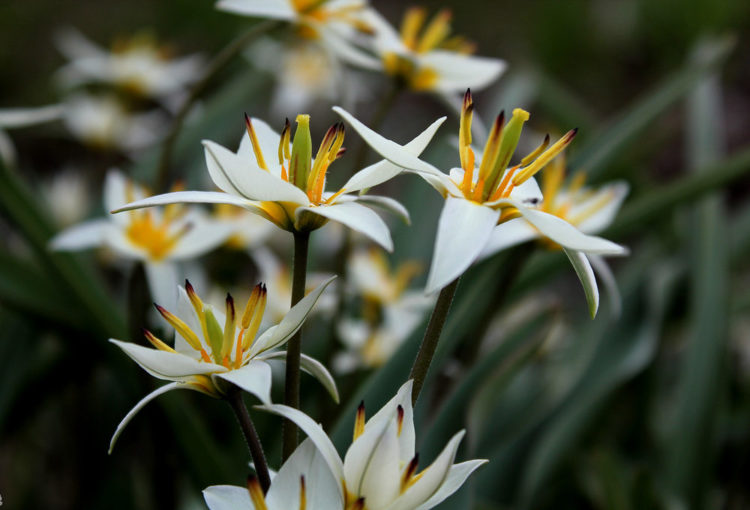
tulip bieberstein - a perennial bulbous plant with thin bluish-green stems up to 30 centimeters high. Bieberstein tulip bud drooping. The flower is wide open, star-shaped, golden yellow or white. Flowering in April - May. This type of tulip for several years can not be dug up.

Tulip Greiga - a plant up to 40 centimeters high. Flowers solitary, large, bright, goblet. Blooms in late April - early May.
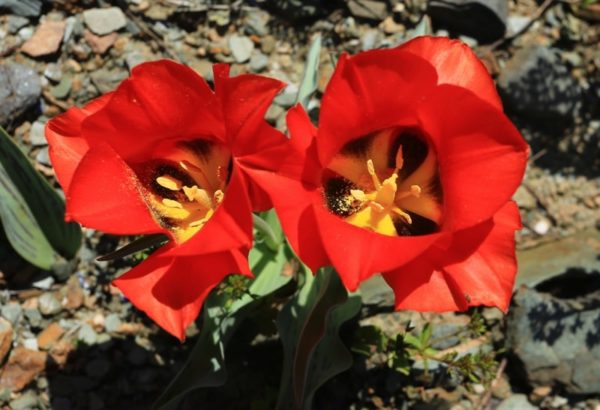
Tulip Foster - plants up to 30 centimeters high. The leaves of the Foster tulip are wide, slightly wavy along the edge. The flowers are large (up to 14 centimeters in diameter), solitary, of various colors. It is used in the design of rock gardens. Flowering in late April - early May.
Tulip Gesner - small plants, height 15-30 centimeters. Flower solitary, red or yellow.
dwarf tulip - plants up to 10 centimeters high. Leaves from 2 to 4, flowers usually 1-2. Flower color - white, pink, lilac. Dwarf tulips are commonly used in the design of rock gardens.
Tulip Lipsky - a bulbous plant 6-10 centimeters high. Leaves deviated, edged with a reddish stripe. Solitary flower with color from light pink to purple. Flowering in May-June.
Tulip Schrenk - a plant up to 40 centimeters high. The leaves are curly, recurved, widely spaced. The flower is solitary, broadly cupped, often red, although there are varieties with a variety of colors.

Tulip hybrid - the combined name of more than 2.5 thousand varieties obtained by crossing several species.
In floriculture, the classification of tulips according to the timing of flowering according to the shape and color of the flowers is also accepted. According to the international register, all varieties and types of tulips are divided into 4 groups, which, in turn, include 15 classes.
early blooming tulips
Tulips simple early - fairly low hardy tulips, resistant to adverse weather conditions. The color of the flowers is usually red or yellow. Early tulips bloom at the end of April.
Tulips terry early - low (up to 30 centimeters high) tulips with large, up to 8 centimeters in diameter, bright double flowers.
Medium blooming tulips
Triumph tulips - plants up to 70 centimeters high with large goblet-shaped flowers of various colors - from white to purple.
Darwin hybrids - very tall flowers, up to 80 centimeters high. The flowers are large, goblet, red or bicolor. Frost resistant.
late blooming tulips
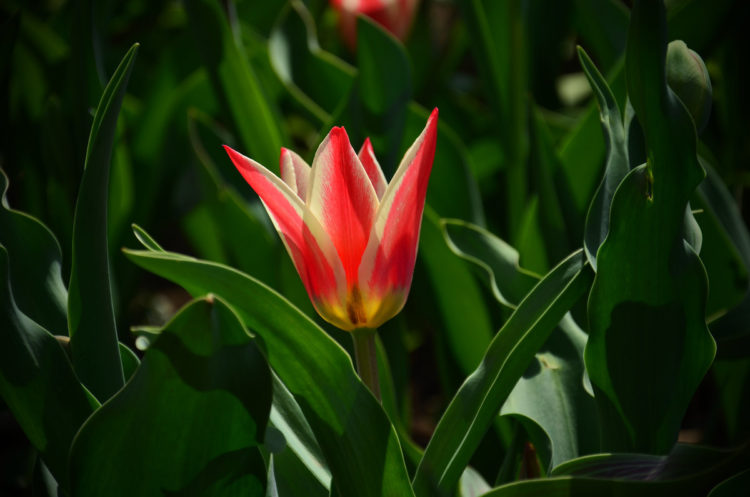
Tulips simple late - powerful plants up to 70-75 centimeters high. Flowers with a square base, petals obtuse. The color of flowers can be white, black, pink, purple, there are two-color varieties. The class of simple late tulips also includes many-flowered tulips (bush tulips) - flowers-bouquets, bearing up to 5 flowers on one peduncle. Late tulip blooms in the second half of May.
tulips - plants up to 60 centimeters high. Flowers of an elegant elongated shape, reminiscent of lilies. The petals are narrow, pointed, bent outward. Lily tulips bloom from mid-May.
Tulips fringed - plants of the most diverse height and color. Fringed tulips are distinguished by the presence of a needle-like fringe along the edge of the petals.
Tulips green - usually medium or tall, with narrow leaves. A distinctive feature of green-colored tulips is green strokes, spots or stripes on the outside of the petal, which, as a rule, looks very impressive on a bright yellow, red, pink or white background. Blooms in the second half of May.
Rembrandt tulips - plants of various heights with variegated goblet-shaped flowers. Strokes, spots, stripes on a red, white or yellow background make these colorful tulips very showy.
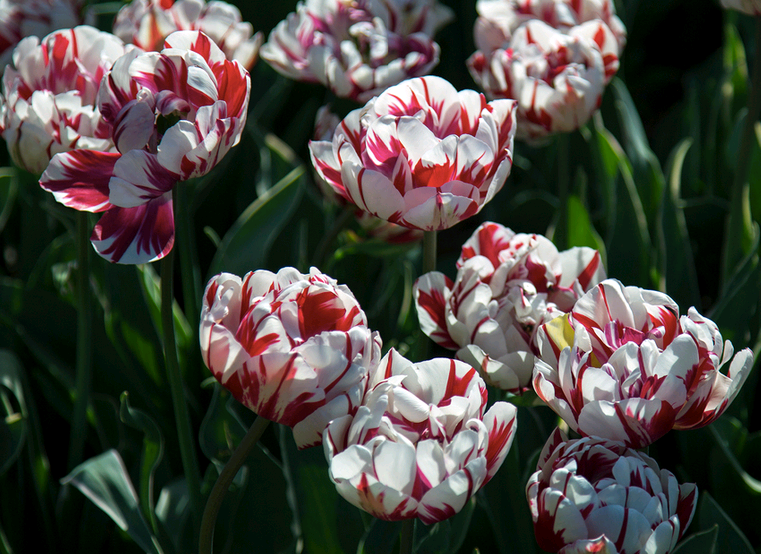
parrot tulips - plants of various heights and colors, characterized by a very exotic flower shape. The rugged, wavy, 'disheveled' petals of this class of tulips resemble a fluffy tropical bird. The flowers can be, in addition, of a huge size.
Tulips terry late , orpeony tulips- differ in very large, bright, densely double flowers of various colors. Less resistant to rain and wind.
Wild-growing types of tulips, their varieties and their hybrids (botanical tulips)
- Kaufman tulips, varieties and hybrids;
- Foster's tulips, varieties and hybrids;
- Greig's tulips, varieties and hybrids;
Tulip care: watering and feeding flowers
For growing tulip flowers, drained neutral or slightly alkaline soil with a high nutrient content is suitable. The plant prefers sunny and sheltered places. In one place without a transplant, it grows well for 3-4 years, but it is recommended to plant it in a new place every year.
Tulip bulbs before planting should be inspected and damaged planting material should be discarded. The fact is that the risk of disease in scratched bulbs is too great to plant them next to healthy ones. The planting material remaining after the inspection should be soaked in a 0.1% solution of decis for about 15-20 minutes.
Watering tulips should be carried out regularly and plentifully, provided that the weather is warm. 3 weeks after the end of flowering, watering is stopped. The soil between the plants is loosened and weeded.
The first top dressing of tulips is carried out after emergence (1 tablespoon of urea per 1 m2. The second time the soil is fertilized before the buds appear. The third top dressing is necessary for tulips during the period of active bud formation. The fourth is at the beginning of flowering. When caring for tulip flowers, fertilizers are used superphosphate, potassium sulfate and special fertilizers for flower plants.
Another tip for growing tulips: for the winter, the site is mulched, and in the spring the mulch is removed. Also, the bulbs can be dug up and stored in a dark, cool room. Tulips are propagated by bulbs. They are planted in autumn in pits to a depth of 3 times the height of the bulbs. The distance between them is made by 15-20 cm. They are sprinkled with earth on top and slightly trampled. The soil is dug up and leveled 10 days before the work, and when planting, wood ash, humus, and nitrophoska are added to it.
Tulips are affected by penicillosis, fusarium, bulbous and tulip sclerotinia, bacterial rot, gray mold, variegation. The most dangerous pest for them is the onion mite.
When digging and planting, it is important to feel the tulip bulbs, trying to lightly squeeze them in the palm of your hand. Soft, sagging under the pressure of the fingers should be culled and destroyed, as they can be affected by diseases.
Medicinal properties
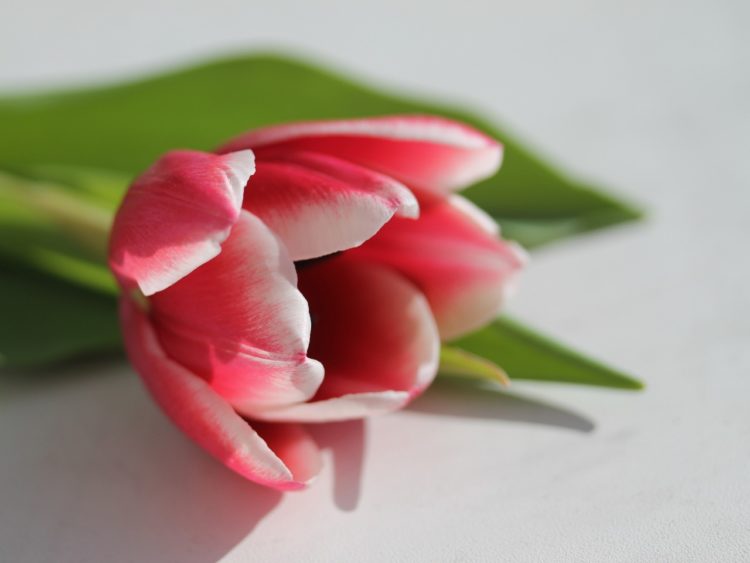
The medicinal properties of tulip flowers, as well as other parts of it, have not been sufficiently studied to date. It is known that tulips contain fiber, sugar, starch. Traditional medicine uses this plant to treat heart disease.
Used in cosmetology tulip oil which you can cook at home. To do this, pour crushed plant petals with olive oil and leave for 14 days. This tool is great for treating rashes, the skin of the face after applying the oil becomes soft and velvety.
Use in cooking
In the cuisine of many countries, tulip flowers are a real delicacy. The flower trend in world cuisine originates from England. In the country of foggy Albion, starting from the 16th century, cookbooks concealed recipes for flower syrups, salads, tinctures, and even candied petals. To date, sweet petals are most popular in France.
Exotic tulip dishes can be tasted in restaurants in the Netherlands. Tulips are valued not only as a dessert, but also as an excellent hot dish, which is obtained by frying their petals in batter. Tulips go well with fish and meat dishes.
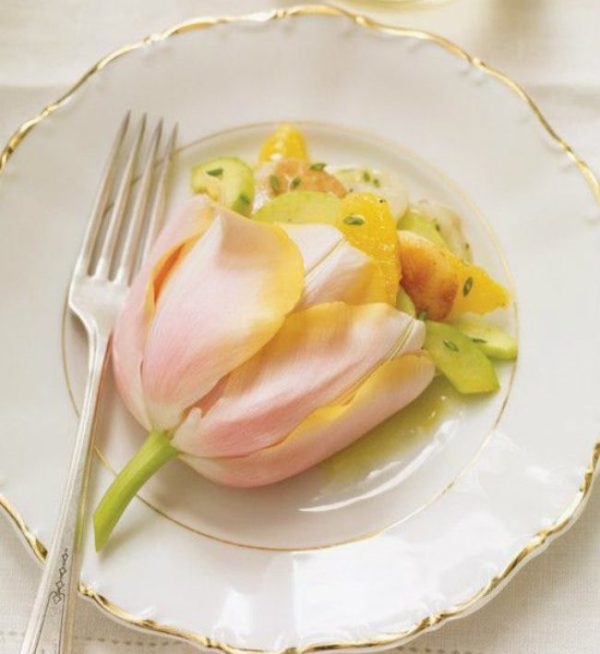
In one of the restaurants in Vancouver, they prepared a real “tulip menu”. In spring, in this restaurant you can taste asparagus and feta cheese with fried tulips, or salad from the shoots of this plant of the Emperor variety. The restaurant also prepares charcoal fish with a warm salad with tulip flowers and sauce. The taste of the buds of these flowers in the sauce resemble the shoots of Brussels sprouts. For dessert, the restaurant offers an amazingly delicious cake with flower petals. The combination of tulips, whipped cream and lemon will not leave anyone indifferent.
At home, you can cook a stunningly delicious dish called " tulip petals in batter". For this dish you will need 3 large red flowers, 150 grams of flour, half a glass of white wine and the same amount of olive oil, chicken egg, 5 grams of yeast. The flour is diluted with wine, then yeast and yolk are added to the mixture, a little water is poured in. The mixture is thoroughly mixed and left to ferment for half an hour. Whipped protein is added to the resulting dough, the petals are first dipped in the dough, and then fried in boiling oil until golden brown. After frying, the petals should be dried on a napkin. The dish is served hot.
Tulip bulbs are also edible, they are baked in a fire, they taste like potatoes, only they have a sweet aftertaste.
The green leaves of the plant are great for making a vitamin salad. Young leaves are cut into strips and mixed with chopped green onions, 1 tablespoon of vinegar is added to the salad. The salad is left for one hour in order to get rid of excess bitterness, then the vinegar is decanted and the salad is seasoned with olive oil.
The benefits of tulip flowers and treatment
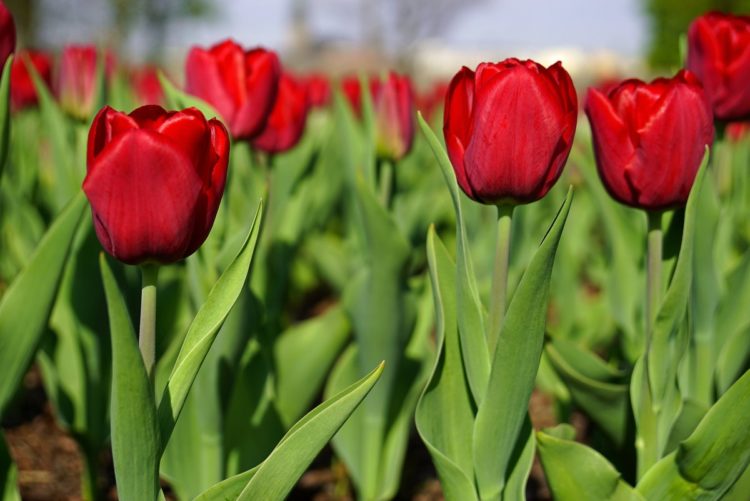
The benefits of tulips are known to Chinese medicine. Edible plant varieties are used in dermatology for the treatment of pustules on the skin and dermatitis, with these diseases, the flower is consumed orally. In folk medicine, the plant is used, knowing about its tonic properties. Chinese healers recommend using this plant for diarrhea, tumors, and poisoning.
Harm of tulip flowers and contraindications
A tulip can cause harm to the body with uncontrolled use. It should be noted that there is a plant of the lily family, which is called "Guenther's tulip". This species is highly toxic and its use can be life-threatening.

